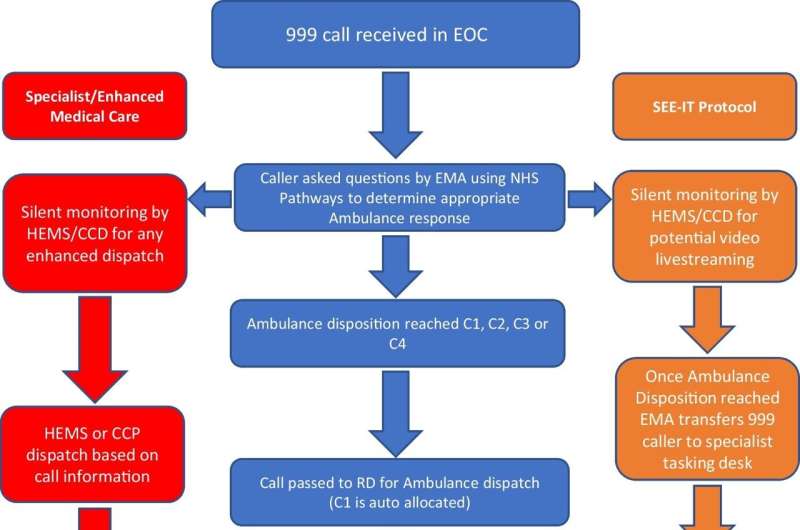This article has been reviewed according to Science X's editorial process and policies. Editors have highlighted the following attributes while ensuring the content's credibility:
fact-checked
trusted source
proofread
Live video streaming from trauma incidents to emergency medical services is feasible, finds study

Live video streaming, used via 999 callers' smartphones, could aid emergency medical services' decision-making about how many and what type of emergency medical personnel and vehicles to send to major trauma incidents.
Building on their previous work evaluating the use of GoodSAM Instant-On-Scene technology, Surrey researchers, in collaboration with Air Ambulance Charity Kent, Surrey and Sussex (KSS), London Ambulance Service (LAS) and South East Coast Ambulance Service (SECAmb), conducted the first randomized controlled trial in the world to evaluate the feasibility of implementing and evaluating the technology in this emergency setting and whether its use would be acceptable to members of the public.
Professor Cath Taylor, Professor of Healthcare Workforce, Organisation and Wellbeing at the University of Surrey's School of Health Services, said, "Most ambulance services in the U.K. rely on callers to verbally relay accurate information about the condition of patients and what has happened at the scene. Often, due to their lack of medical knowledge and the shock of what they have witnessed, the information they provide may be unintentionally inaccurate.
"Not having correct information makes it difficult for emergency medical services to determine how many and what types of medical personnel and vehicles should be sent to the scene. Using GoodSAM could help us overcome this. However, we need to understand the practicalities of implementing and evaluating such technology within emergency services."
Researchers trialed the technology over six weeks between June and November 2022. They randomized the working shifts of those responsible for dispatching enhanced care resources (such as the air ambulance) to either use live video streaming or not. A total of 62 working shifts were randomized, and 240 trauma incidents were included throughout the trial.
All 999 callers during intervention periods spoke to emergency call handlers as normal, who then transferred the call to enhanced care dispatchers who asked the callers permission to use live streaming and assessed if GoodSAM technology was safe to be used.
The study is published in the Scandinavian Journal of Trauma, Resuscitation and Emergency Medicine.
Out of the incidents that occurred during intervention working shifts, 72 were confirmed as eligible to use GoodSAM; of those, 86% of the callers were willing and able to use the technology. This resulted in the footage being viewed in 85% of these calls. Though the study was not designed to evaluate the impact on decision-making, livestreaming directly led to changes to dispatch decisions, including the KSS air ambulance being stood down in two instances, saving money and enabling them to be redeployed elsewhere.
Professor Richard Lyon MBE, professor of pre-hospital emergency care at the University of Surrey and Director of Research and Innovation at Air Ambulance Charity Kent, Surrey, Sussex, said, "Giving dispatchers eyes on the ground could be game-changing in helping them dispatch the appropriate response to major trauma incidents. Air ambulance services are important, scarce and expensive resources that must be tasked accurately to those patients who need them most.
"What we have found is live video streaming from 999 callers is feasible to implement, acceptable, and easy to use for both callers and dispatchers. More research is needed to understand the impact that live streaming has on dispatch decisions, and whether it can improve the speed and accuracy of ambulance dispatch. We also found it challenging to recruit 999 callers to the study and need to work with members of the public to overcome this challenge for future research, as their insight is invaluable."
Professor Julia Williams, a paramedic and Head of Research for the South East Ambulance Service NHS Foundation Trust reported, "This study is really important for patients to ensure they get the most appropriate emergency response in the quickest time possible. There are many ways that we can use this type of technology to improve the emergency health care services that we provide to our population and this approach has shown great promise in our research study.
"It is vital that our developing services are based on evidence and research findings. This research is a great example of different organizations working together for our patients' benefit and, at the same time, it gave us an opportunity to make sure that our staff could effectively use this technology with no harm to them or the callers."
More information: Cath Taylor et al, The SEE-IT Trial: emergency medical services Streaming Enabled Evaluation In Trauma: a feasibility randomised controlled trial, Scandinavian Journal of Trauma, Resuscitation and Emergency Medicine (2024). DOI: 10.1186/s13049-024-01179-0

















